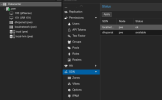Good day everyone,
I am in the process of changing ISP (to Init7) and I bought a R86S-U4 for that, I want to install pfsense on proxmox on it
In an ideal world, I plug an ethernet cable on the router and my pc and boom I can access the webgui.. but that's just too beautiful to work that simply
The router has 3 ethernet ports (Intel I believe, not really important to know) and 2 SFP+ ports (Mellanox device), one of them for the optic fiber
Currently I am able to access the webgui by passing the traffic through my old router, so if I do need to make configurations through the webgui I technically can. It's just that in this setup I can't actually configurate pfsense, and then I'd have no guarantee that I can access proxmox webgui once my old router is gone, and it would be extremely bad to rely on pfsense for that. Proxmox should ultimately be accessible even if the VM is down
I am 100% certain I am being stupid, but the more I do the less I understand and the less I know what next step I should take, I need some external pair of eyes
Now is the moment where I describe what I tried:
At first I tried modifying the network interfaces (enp2s0 is where my pc is connected to and enp3s0 is where the R86S is connected to the old router)
I also tried using isc-dhcp-server following this guide https://first2host.co.uk/blog/proxmox-dhcp-server/ and followed along exactly, but it didn't want to start
Lastly, I also tried making a local network directly with built-in features under the "datacenter" tab

Here is the zones:

Here is the VNets: (IP ranging from 192.168.0.1 to 192.168.0.255)

I also tried making the LAN with pfsense in the VM, but that wasn't convincing. (I put every vmbr as network cards in the VM)
With all that, I also made sure that my pc has the IP 192.168.0.100/24 on its ethernet port (and for good measures, disabled iwd to be only connected to the R86S)
Any idea on what I should do?
I am in the process of changing ISP (to Init7) and I bought a R86S-U4 for that, I want to install pfsense on proxmox on it
In an ideal world, I plug an ethernet cable on the router and my pc and boom I can access the webgui.. but that's just too beautiful to work that simply
The router has 3 ethernet ports (Intel I believe, not really important to know) and 2 SFP+ ports (Mellanox device), one of them for the optic fiber
Currently I am able to access the webgui by passing the traffic through my old router, so if I do need to make configurations through the webgui I technically can. It's just that in this setup I can't actually configurate pfsense, and then I'd have no guarantee that I can access proxmox webgui once my old router is gone, and it would be extremely bad to rely on pfsense for that. Proxmox should ultimately be accessible even if the VM is down
I am 100% certain I am being stupid, but the more I do the less I understand and the less I know what next step I should take, I need some external pair of eyes
Now is the moment where I describe what I tried:
At first I tried modifying the network interfaces (enp2s0 is where my pc is connected to and enp3s0 is where the R86S is connected to the old router)
I can only access the web-gui if I put the IP under vmbr2 instead and as 192.168.1.<whatever>/24 (and of course the appropriate gateway)
JSON:
auto lo
iface lo inet loopback
iface enp1s0 inet manual
iface enp2s0 inet manual
iface enp3s0 inet manual
iface enp5s0 inet manual
iface enp5s0d1 inet manual
iface wlo1I am absolutely certain I am being stupid, but the more I do the less I understand and I need some external pair of eyes inet manual
auto vmbr0
iface vmbr0 inet static
bridge-ports enp1s0
bridge-stp off
bridge-fd 0
auto vmbr1
iface vmbr1 inet static
address 192.168.0.22/24
gateway 192.168.0.1
bridge-ports enp2s0
bridge-stp off
bridge-fd 0
auto vmbr2
iface vmbr2 inet manual
bridge-ports enp3s0
bridge-stp off
bridge-fd 0
auto vmbr3
iface vmbr3 inet manual
bridge-ports enp5s0
bridge-stp off
bridge-fd 0
auto vmbr4
iface vmbr4 inet manual
bridge-ports enp5s0d1
bridge-stp off
bridge-fd 0
source /etc/network/interfaces.d/*I also tried using isc-dhcp-server following this guide https://first2host.co.uk/blog/proxmox-dhcp-server/ and followed along exactly, but it didn't want to start
Lastly, I also tried making a local network directly with built-in features under the "datacenter" tab

Here is the zones:

Here is the VNets: (IP ranging from 192.168.0.1 to 192.168.0.255)

I also tried making the LAN with pfsense in the VM, but that wasn't convincing. (I put every vmbr as network cards in the VM)
With all that, I also made sure that my pc has the IP 192.168.0.100/24 on its ethernet port (and for good measures, disabled iwd to be only connected to the R86S)
Any idea on what I should do?
Last edited:

